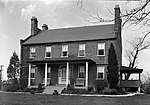1949 U.S. Women's Open
1949 in American women's sports1949 in sports in Maryland1949 in women's golfGolf in MarylandSeptember 1949 sports events in the United States ... and 3 more
Sports competitions in MarylandU.S. Women's OpenWomen's sports in Maryland
The 1949 U.S. Women's Open was the fourth U.S. Women's Open, held September 22–25 at Prince George's Country Club in Landover, Maryland, a suburb east of Washington, D.C. Louise Suggs led wire-to-wire and won the first of her two U.S. Women's Open titles, fourteen strokes ahead of runner-up Babe Zaharias, the defending champion. It was the fourth of eleven major championships for Suggs. The course no longer exists and is now the site of Kentland Community Center Park.
Excerpt from the Wikipedia article 1949 U.S. Women's Open (License: CC BY-SA 3.0, Authors).1949 U.S. Women's Open
Pinebrook Avenue,
Geographical coordinates (GPS) Address Nearby Places Show on map
Geographical coordinates (GPS)
| Latitude | Longitude |
|---|---|
| N 38.924 ° | E -76.895 ° |
Address
Prince George's Ballroom
Pinebrook Avenue
20785
Maryland, United States
Open on Google Maps








